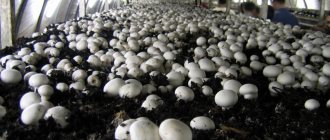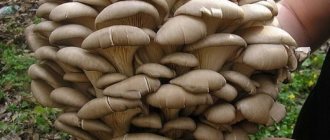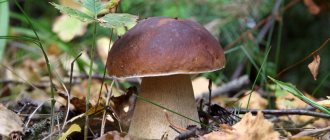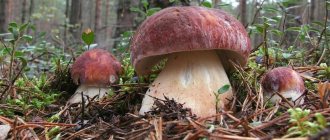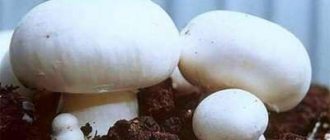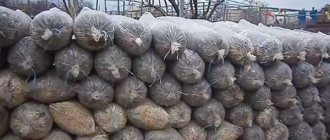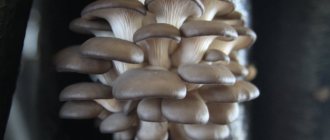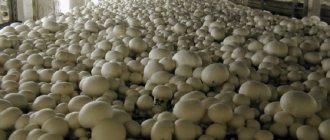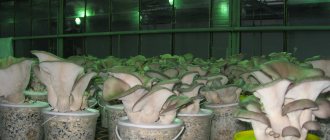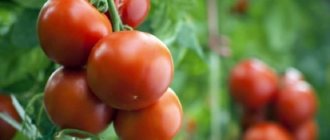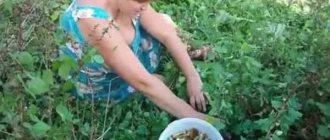One of the most popular and sought-after areas in modern agriculture is growing mushrooms in greenhouses. Mushrooms are one of the largest sources of plant protein, fiber, carbohydrates, vitamin D and magnesium. In addition, mushrooms are very tasty, and many different dishes can be prepared using them. The huge abundance of varieties and types of this wonderful product will not leave you indifferent. The only drawback of mushrooms is their seasonality, but greenhouse cultivation makes it possible to collect fresh and aromatic mushrooms all year round.
Find out how to properly grow champignons and oyster mushrooms in a greenhouse!
The main advantages of growing champignons in a greenhouse
- The process of growing mushrooms in greenhouses and hotbeds has many advantages, among which the most notable are:
- Environmental friendliness - it is known that mushrooms have a high absorbing ability, and therefore can become a source of harmful substances and be toxic to the human body.
- This probability especially increases when picking mushrooms near roads or in areas with a low environmental rating. Based on these indicators, poisoning from mushrooms grown in greenhouse conditions is reduced to zero.
- The opportunity to open your own business - mushrooms are one of the products for which the demand never decreases, and therefore can become a fairly significant addition to the household budget.
- Harvesting all year round - growing mushrooms in greenhouses makes it possible to harvest at any time, regardless of the current season.
- Minimum costs - funds will be needed to purchase biomaterials and work on arranging the greenhouse. However, as practice shows, such expenses quickly pay off.
Where to sell finished products?
Business is seasonal. The demand for champignons increases in winter and spring. In summer and autumn the rate drops. The reason is the appearance of forest mushrooms.
You can sell mushrooms in grocery stores and chain stores. They are reluctant to cooperate and demand payment for shelf space. An alternative is to sell mushrooms to processors, resellers, cafes and restaurants. You can also sell mushrooms at your point of sale - if it is equipped with a refrigerator.
Types of mushrooms recommended for greenhouses
There are also mushrooms that are most popular among farmers:
- oyster mushroom - takes first place, which is due to its high productivity and short reproductive cycle (the main competitors are winter honey mushrooms and ring mushroom);
- champignons are more “capricious” mushrooms that require a complex technological process of soil preparation;
- porcini mushrooms , morels , shiatake - despite their popularity and fairly high prices, growing these mushrooms is not very difficult.
Honey mushrooms
Honey mushrooms are successfully cultivated in a greenhouse. The natural place of cultivation is hollows and stumps. Found in nature from October to December.
Characteristic
There are 2 varieties suitable for home cultivation: winter and summer. The winter variety has excellent taste. The caps are rusty brown in color and reach 9 cm in diameter. Summer honey mushrooms are smaller in size, but have a milder taste and are suitable for fresh consumption.
Features of planting and care in a greenhouse
Mycelium serves as planting material. To grow on stumps, a timber beam made of dense wood with a diameter of more than 15 cm is required. The stump must be saturated with moisture both inside and outside. The growing area is suitable for use for 5 years. Growing honey mushrooms is associated with the risk of infection of nearby growing trees. Germination of mycelium into the root system will lead to the death of the crop.
The use of greenhouse conditions allows you to obtain maximum yield due to the large area. The soil surface is lined with half-rotten logs and moistened with spore mash. Plantings should be irrigated daily from noon to evening at intervals of 1 hour. The mycelium will be ready for harvesting from mid-June. Fruiting continues until autumn.
Basic requirements for a greenhouse
When starting to choose a greenhouse, you should know that mushrooms are unpretentious crops, and their cultivation does not require special conditions. But it is worth considering that the maintenance rules vary somewhat, depending on the type of plant being grown. For example, oyster mushrooms can grow in cellars and basements, and champignons can grow in film greenhouses.
The main thing is not the type of greenhouse itself, but compliance with the most important environmental parameters:
- Lighting - mushrooms do not tolerate direct sunlight, under the influence of which they dry out and die. When growing mushrooms in greenhouses, you should shade the walls with a net or paint them with chalk mortar.
- Temperature and humidity - heat is contraindicated for mushrooms, because it is at low temperatures that the formation and intensive growth of new bodies occurs. As for humidity, its level should be high - about 90%.
- Ventilation - increases the comfort of mushroom growth and is achieved by ventilation or installing a special ventilation system.
Important! To increase and maintain the required level of humidity, sawdust is laid out on the floor of the greenhouse, capable of both absorbing moisture and releasing it if necessary.
Useful tips
To build a greenhouse and safely grow mushrooms in it, you should take into account a number of recommendations from experts:
- For the structural frame, the best material is aluminum, as it is lightweight and wear-resistant. In addition, such material is not afraid of corrosion, and mold will not form on it even in conditions of high humidity. For the same reasons, it is worth installing shelving and racks made of aluminum in the mycelium.
- In order to improve thermal insulation, the floor should be covered with foamed polyethylene or other material that has similar properties. In addition, it is necessary to pay due attention to sealing the greenhouse, since any cracks and holes in the shelter lead to a decrease in the heat level, and therefore to an increase in heating costs.
- The greenhouse in which it is planned to grow mushrooms cannot have a translucent or transparent roof. It needs to be built or converted in such a way that the incoming light is dim. To do this, you can use several tricks: paint the translucent ceiling with chalk;
- tint the roof and walls with special adhesive tape or mesh;
- curtain with synthetic translucent fabric.
If you need to organize additional lighting inside the greenhouse, you can install fluorescent lamps.
Features of growing champignons at home
Champignons are a very popular product that is used everywhere in the preparation of various dishes. At the same time, this type of mushroom is perfect for growing by beginners, since they are unpretentious in care and do not require large financial investments to purchase mycelium and consumables.
The entire process of cultivating champignons begins with the selection of a place for cultivation, acquisition of mycelium, preparation of the substrate and optimal conditions for the development of the mycelium. At the same time, the quality of compost requires special attention - its humidity level should not be higher than 70%, nitrogen levels should be in the range of 2–2.5%, and the acidity level of the substrate should not be higher than 7.5 units.
Video: How to make money on mushrooms at home on an industrial scale
How to prepare mycelium
Preparing mycelium for sowing consists of several main stages:
- Aging - since the mycelium is stored at a temperature of +2...+4° C, but the process of its growth is practically stopped. In order for the grains to immediately begin to grow after sowing into compost, the boxes with mycelium are kept for 20–24 hours at room temperature in a clean room.
- Rejection - before sowing, each bag of planting material should be carefully checked. If, upon inspection, a sour odor is clearly felt, mold is detected, changes in color, or mechanical damage is noticeable on the packaging, the contents of the package are not used for sowing compost.
During long-term storage, the mycelium overgrows and turns into a solid dense mass. Before sowing, it should be shaken and the lumps carefully broken up, without damaging the integrity of the bag and minimally damaging the grains.
Planting mycelium
The first and most necessary condition for growing champignons is a properly prepared mycelium.
A substrate with an area of 1 m² is prepared from the following components:
- 1/3 c of straw or sawdust;
- leaves;
- winter wheat grain;
- tops (ideally vegetable);
- cow or horse manure;
- 100–150 liters of water;
- 750 g urea;
- 700 g superphosphate;
- 3 kg of gypsum;
- 700 g chalk.
It is better to prepare and mix the substrate either in a well-ventilated area, using a respiratory mask, or outdoors (while avoiding getting water or direct sunlight into the mixture).
20–25 days before the intended planting of the mycelium, straw and other plant components are soaked in water for 24 hours. After this, a stack of substrate is prepared layer by layer: a layer of manure - several layers of straw and plant parts. Each layer is sprinkled with chalk, gypsum and fertilizers, and is also actively wetted with water. The substrate is kept covered for the required period.
The next step is the planting process itself. The volume of the prepared mixture will require about 450 g of mycelium. During the planting process, the soil layer is lifted and planting material, the size of which does not exceed a tennis ball, is located at a depth of 4–5 cm.
Each hole is located at a distance of 15–20 cm from the other. The most optimal arrangement is in a checkerboard pattern. Mycelium in grains does not require a special planting scheme - it is simply distributed evenly over the entire surface of the nutrient mixture and covered with a layer of substrate.
Fertilization
Champignons, like other mushrooms, reproduce through spores that form on plates under the cap. Also, one of the methods of reproduction is the vegetative way (division of the mycelium). The cells of a piece of a mushroom cap placed in a sterile environment multiply at tremendous speed, forming mycelium (tissue reproduction).
Champignon business: profitability and payback - calculations
The minimum cost to start a business is 700,000 rubles. Most of the money will be needed to purchase growing equipment. It is difficult to create and maintain a microclimate. Monthly expenses are about 70,000 rubles. You have to pay rent, make utility bills, pay taxes, pay salaries to staff.
You will reap the first harvest no earlier than 1.5 - 2 months from the moment the business is launched. Therefore, include monthly expenses for this period in your starting capital. In general, the launch will require about 1 million rubles.
The retail price of 1 kg of champignons is 250 rubles. For wholesale sales, the figure is reduced to 150 rubles. From 100 square meters in a month you can get about 2000 kg of champignons. One mycelium produces 6 harvests per year. The total earnings will be 1,800,000 rubles per year. Average monthly profit - 150,000 rubles. Business profitability is 25 - 40%. The business will pay off within one year. With an increase in space, income will increase, but personnel and rental costs will also increase.
| Index | Meaning |
| Initial investment amount | 1 million rubles |
| Monthly expenses | 70 thousand rubles |
| Monthly income | 150 thousand rubles |
| Net profit per month | 80 thousand rubles |
| Payback period | From 1 year |
Rules of care
Caring for this type of mushroom does not require much effort or time. By following simple recommendations, you can easily achieve a good harvest.
Temperature
Air temperature is the main indicator of the future harvest, since in conditions of elevated temperatures, the growth and development of mushrooms stops. The optimal temperature for the room is +14...+16° C. Also, after the first mushrooms appear, you should ventilate the room several times a day or use a ventilation system that can reduce the concentration of carbon dioxide.
How to water
Another important factor is timely and regular watering of the soil, as well as maintaining the required level of humidity in the room. Watering the substrate begins 8–10 days after preparation. For these purposes, you can use a small watering can with water supply in the form of small drops.
You should be extremely careful with this procedure, since water, penetrating deeper than the covering layer of the substrate (into the compost) can cause the mycelium to rot. The humidity level in the room should be within 70%. Such results can be easily achieved by installing open containers around the entire perimeter filled with water.
What to feed
Most often, the prepared or purchased substrate does not contain the full range of additives necessary for the growth and development of fungi. That is why, to enrich the mixture and accelerate the growth of mycelium, special fertilizers are used.
When starting feeding, you should consider some points:
- the fertilization procedure should be carried out in conditions of increased sanitation and hygiene;
- fertilizer must be distributed as evenly as possible throughout the substrate;
- the introduction of additives having a high concentration should be carried out with extreme caution - a large amount can sharply reduce the level of yield.
Did you know? The largest mushroom was found in the United States in the mid-80s
-
x years.
Its weight was 140 kg, and its diameter was
more than 2 meters.
There are several types of fertilizers that may be needed in the process of growing mushrooms:
- gypsum - has a positive effect on the structure of the substrate and is necessary for fungal metabolic processes;
- urea - increases the rate of compost decomposition;
- potassium chloride - takes an active part in growth processes;
- calcium nitrate - participates in accelerating the processes of nitrogen absorption;
- sulfur is an integral element of cellular structure;
- Hydrogen peroxide - prevents infection of fungi.
Video: Growing champignons
Business risks
Business is associated with the following risks:
- Mushrooms die or do not sprout. This is what novice entrepreneurs face when they immediately organize large mushroom plantations. As a result, the entrepreneur suffers losses. To minimize the risk, start a small mushroom growing company initially. In a couple of months, you will understand whether it is worth expanding your company.
- The crop is destroyed by pests and diseases. Ventilation and regular cleaning help reduce the likelihood of losses.
- It was not possible to find buyers. Take care of sales in advance. Otherwise, you will grow too many mushrooms, and mushrooms cannot be stored for a long time.
When creating a business on champignons, take into account the growing conditions of the product - mushrooms are sensitive to the state of the compost and the environment. Find buyers in advance, since mushrooms are a perishable product. If the business is profitable, expand the area. From 300 sq. m. you can collect up to 100 tons of mushrooms per year.
Harvest and storage
The first harvest of champignons can be harvested 30–35 days after sowing the mycelium. At the same time, the period of active growth lasts 3–4 days. The fruiting period is 2–3 months and has a wave character - during the fruiting period you can collect about 15 kg per 1 m², and then there is a lull. Afterwards, active fruiting resumes.
The first few waves have the largest amount of harvest (there can be about 7 in total). The level of maturity of the mushroom is determined by the state of its film, which connects the stem and cap of the fruit - full maturity is characterized by its darkening.
The main question: how to properly collect champignons? Harvesting is carried out without a knife - the mushrooms are carefully twisted out of the substrate, trying not to damage the rudiments of the fruiting bodies and mycelium. After harvesting, the compost is removed (it can be used as fertilizer in beds and flower beds), and the room itself is treated with a 4% bleach solution.
It is best to store champignons in the refrigerator, unwashed, at a temperature of +4...+6° C. To reduce moisture loss, it is best to use resealable containers or a plastic bag (in this case, it should be opened once every 3 days for ventilation).
In general, the procedure for growing mushrooms does not require special knowledge and does not cause much trouble, and the results will please any gardener. After familiarizing yourself with a small amount of information, any summer resident, professional or beginner, can easily get a rich harvest and the opportunity to enjoy mushrooms throughout the year.
Chanterelles
Chanterelle mushrooms are small to medium in size, can weigh up to 90g, and have a convex shape with a wavy cap connected to a dense stem. The variety refers to mushrooms for which heat treatment is not necessary. The possibility of eating raw allows you to get the maximum benefit from the substances included in the composition.
Characteristic
Externally, they look like an umbrella turned inside out. The cap is smooth, delicate, golden-orange in color with uneven edges. It is fused with the stalk, and the diameter of the cap varies between 5-10 cm. Under the cap there are forked ridges with blunt edges that descend to a golden-orange solid stalk. The flesh of the mushroom is pale white in color and has a fruity aroma with notes of apricot and peach.
They grow next to spruces, pines, beeches and oaks, merging with the roots of the trees through mycelium. Among the edible species, the most popular are faceted and velvety chanterelles. With good organization of the site, the yield can be up to 100 kg per 1 hectare of planting. For 5 years, the yield remains at a high level, but as the substrate is depleted, the yield drops to 50 kg.
Features of planting and care in a greenhouse
You can plant chanterelles using caps, tincture of caps or mycelium:
- Withered caps of old mushrooms are removed and laid out on moist soil.
- To prepare the tincture, the caps are filled with water and a few tablespoons of sugar are added. The softened caps are filtered and the area is poured with the tincture.
- You can get mycelium yourself by digging up the soil near the mushrooms in the forest. The mycelium should be moistened and planted in a new place.
To grow chanterelle mushrooms in a greenhouse, you can dig up a mycelium in the forest.
The difficulty in growing chanterelles on the site is the need to imitate wild conditions. You will need to make a soil mixture similar to the root zone. Mycelium should be planted in early summer when warm weather sets in. Growing coniferous trees next to the greenhouse guarantees better survival rate of planting material and high productivity.
Planting mycelium
It is necessary to plant mycelium with clean hands or gloves to avoid infection with infections and bacteria. The mycelium can be planted in pieces in a checkerboard pattern at a distance of 30 cm from each other. One piece is 2-3 cubic centimeters. Next, everything is covered with manure and compacted lightly.
How to prepare the substrate
Before sowing the mycelium, it is necessary to carefully prepare the substrate and disinfect it.
Soil for mushrooms consists of parts:
- Straw, sawdust, old branches - 1/3 part
- Old leaves - 1/3 part
- Wheat grains – 1/5 part
- Tops – 1/ parts
- Turkey droppings – 1/5 part
- Phosphates – 1/5 part
- Leaf soil - 1/3 part
- Ash – 1/3 part
- Plaster, chalk, eggshells – 1 part
Important! If you use other than turkey droppings, you need to add urea. These ingredients contain nitrogen, which the mycelium needs to grow.
All organic parts of the substrate - leaves, sawdust, branches - must be scalded with boiling water and treated with a solution of potassium permanganate. Otherwise, other fungi will germinate faster than the champignons; most likely, it will be ordinary mold. All components are laid out in boxes in layers, which must be covered with earth.
Advice. It is better to use medium-sized boxes. Large and voluminous boxes with an area of 1 square. meter will be too heavy and difficult to rearrange or move.
The moistened substrate should ferment within a month. At the same time, it must be regularly watered with a solution of potassium permanganate or fungicides. This is necessary to remove germinated spores of mold or other fungi that may contain leaves, straw or sawdust. The boxes must be kept in a warm room.
